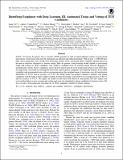| dc.contributor.author | Yu, Liang | |
| dc.contributor.author | Huang, Chelsea | |
| dc.contributor.author | Crossfield, Ian | |
| dc.contributor.author | Daylan, Tansu | |
| dc.contributor.author | Ricker, George R. | |
| dc.contributor.author | Vanderspek, Roland K. | |
| dc.contributor.author | Latham, David W. | |
| dc.contributor.author | Seager, Sara | |
| dc.contributor.author | Glidden, Ana | |
| dc.date.accessioned | 2020-04-17T01:52:13Z | |
| dc.date.available | 2020-04-17T01:52:13Z | |
| dc.date.issued | 2019-07 | |
| dc.date.submitted | 2019-04 | |
| dc.identifier.issn | 1538-3881 | |
| dc.identifier.uri | https://hdl.handle.net/1721.1/124704 | |
| dc.description.abstract | NASA's Transiting Exoplanet Survey Satellite (TESS) presents us with an unprecedented volume of space-based photometric observations that must be analyzed in an efficient and unbiased manner. With at least ∼1,000,000 new light curves generated every month from full-frame images alone, automated planet candidate identification has become an attractive alternative to human vetting. Here we present a deep learning model capable of performing triage and vetting on TESS candidates. Our model is modified from an existing neural network designed to automatically classify Kepler candidates, and is the first neural network to be trained and tested on real TESS data. In triage mode, our model can distinguish transit-like signals (planet candidates and eclipsing binaries) from stellar variability and instrumental noise with an average precision (the weighted mean of precisions over all classification thresholds) of 97.0% and an accuracy of 97.4%. In vetting mode, the model is trained to identify only planet candidates with the help of newly added scientific domain knowledge, and achieves an average precision of 69.3% and an accuracy of 97.8%. We apply our model on new data from Sector 6, and present 288 new signals that received the highest scores in triage and vetting and were also identified as planet candidates by human vetters. We also provide a homogeneously classified set of TESS candidates suitable for future training. ©2019 | en_US |
| dc.description.sponsorship | NSF (grant no. AST-1824644) | en_US |
| dc.language.iso | en | |
| dc.publisher | American Astronomical Society | en_US |
| dc.relation.isversionof | 10.3847/1538-3881/AB21D6 | en_US |
| dc.rights | Article is made available in accordance with the publisher's policy and may be subject to US copyright law. Please refer to the publisher's site for terms of use. | en_US |
| dc.source | The American Astronomical Society | en_US |
| dc.title | Identifying exoplanets with deep learning. III, Automated triage and vetting of TESS candidates | en_US |
| dc.title.alternative | Identifying exoplanets with deep learning. 3, Automated triage and vetting of TESS candidates | en_US |
| dc.type | Article | en_US |
| dc.identifier.citation | Yu, Liang, et al., "Identifying exoplanets with deep learning. III, Automated triage and vetting of TESS candidates." Astronomical journal 158, 1 (July 2019): no. 25 doi 10.3847/1538-3881/AB21D6 ©2019 Author(s) | en_US |
| dc.contributor.department | Massachusetts Institute of Technology. Department of Physics | |
| dc.contributor.department | MIT Kavli Institute for Astrophysics and Space Research | |
| dc.contributor.department | Massachusetts Institute of Technology. Department of Earth, Atmospheric, and Planetary Sciences | |
| dc.contributor.department | Massachusetts Institute of Technology. Department of Aeronautics and Astronautics | |
| dc.relation.journal | Astronomical journal | en_US |
| dc.eprint.version | Final published version | en_US |
| dc.type.uri | http://purl.org/eprint/type/JournalArticle | en_US |
| eprint.status | http://purl.org/eprint/status/PeerReviewed | en_US |
| dc.date.updated | 2020-04-09T16:46:29Z | |
| dspace.orderedauthors | Yu, Liang ; Vanderburg, Andrew ; Huang, Chelsea ; Shallue, Christopher J. ; Crossfield, Ian J. M. ; Gaudi, B. Scott ; Daylan, Tansu ; Dattilo, Anne ; Armstrong, David J. ; Ricker, George R. ; Vanderspek, Roland K. ; Latham, David W. ; Seager, Sara ; Dittmann, Jason ; Doty, John P. ; Glidden, Ana ; Quinn, Samuel N. | en_US |
| dspace.date.submission | 2020-04-09T16:46:32Z | |
| mit.journal.volume | 158 | en_US |
| mit.journal.issue | 1 | en_US |
| mit.license | PUBLISHER_POLICY | |
| mit.metadata.status | Complete | |
